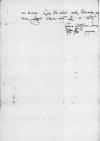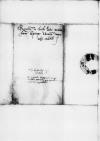Quod ipsa Hanna Czerna (Hanna of Witowice, Hanna Schwarzenberg) (†after 1547), the second wife of Lucas von Allen starosta of Rogoźno; then wife of Stanisław Sokołowski of Wrząca Wielka starosta of Rogoźno⌊praefecta RogosnensisHanna Czerna (Hanna of Witowice, Hanna Schwarzenberg) (†after 1547), the second wife of Lucas von Allen starosta of Rogoźno; then wife of Stanisław Sokołowski of Wrząca Wielka starosta of Rogoźno⌋ hactenus ab Stanisław Sokołowski of Wrząca Wielka son of Jarosław Jan Sokołowski of Wrząca Wielka (d. 1517/1518); 1540-1557 (or 1559?) starosta of Rogoźno (PSB 40/1, p. 146-147 (RUTKOWSKA, "Sokołowski Jarosław Jan z Wrzący Wielkiej"))⌊eo homineStanisław Sokołowski of Wrząca Wielka son of Jarosław Jan Sokołowski of Wrząca Wielka (d. 1517/1518); 1540-1557 (or 1559?) starosta of Rogoźno (PSB 40/1, p. 146-147 (RUTKOWSKA, "Sokołowski Jarosław Jan z Wrzący Wielkiej"))⌋
non sit libera, exanimo profecto dolemus. Locutaeque eramus cum magnifico Andrzej Górka (Andrzej of Górka) (*ca. 1500 – †1551), 1533 castellan of Kalisz; 1535 - of Poznań; 1536 general-starosta of Wielkopolska; 1541 envoy of king Sigismund I Jagiellon to Vienna, to undertake mediation between Ferdinad I von Habsburg and Isabella Jagiellon, widow of János I Zápolya (PSB 8, p. 401-405)⌊castellano PosnaniensiAndrzej Górka (Andrzej of Górka) (*ca. 1500 – †1551), 1533 castellan of Kalisz; 1535 - of Poznań; 1536 general-starosta of Wielkopolska; 1541 envoy of king Sigismund I Jagiellon to Vienna, to undertake mediation between Ferdinad I von Habsburg and Isabella Jagiellon, widow of János I Zápolya (PSB 8, p. 401-405)⌋ ea de re. Andrzej Górka (Andrzej of Górka) (*ca. 1500 – †1551), 1533 castellan of Kalisz; 1535 - of Poznań; 1536 general-starosta of Wielkopolska; 1541 envoy of king Sigismund I Jagiellon to Vienna, to undertake mediation between Ferdinad I von Habsburg and Isabella Jagiellon, widow of János I Zápolya (PSB 8, p. 401-405)⌊QuiAndrzej Górka (Andrzej of Górka) (*ca. 1500 – †1551), 1533 castellan of Kalisz; 1535 - of Poznań; 1536 general-starosta of Wielkopolska; 1541 envoy of king Sigismund I Jagiellon to Vienna, to undertake mediation between Ferdinad I von Habsburg and Isabella Jagiellon, widow of János I Zápolya (PSB 8, p. 401-405)⌋, existentibus nobis adhuc in Łobzów, village near Cracow, today a district of Cracow⌊LobszowŁobzów, village near Cracow, today a district of Cracow⌋ et nunc Piotrków (Petricovia), city in central Poland, in the 15th-16th century the location of the assemblies of the Diet (Sejm) of the Kingdom of Poland, today Piotrków Trybunalski⌊PiotrcoviaePiotrków (Petricovia), city in central Poland, in the 15th-16th century the location of the assemblies of the Diet (Sejm) of the Kingdom of Poland, today Piotrków Trybunalski⌋ solicitantibus eum, nobis promissit illuc familiarem suum discretum cognomento Caczcowski mittere, ut omnia, ... illegible⌈...... illegible⌉ quae cum Hanna Czerna (Hanna of Witowice, Hanna Schwarzenberg) (†after 1547), the second wife of Lucas von Allen starosta of Rogoźno; then wife of Stanisław Sokołowski of Wrząca Wielka starosta of Rogoźno⌊ipsa RogosnensisHanna Czerna (Hanna of Witowice, Hanna Schwarzenberg) (†after 1547), the second wife of Lucas von Allen starosta of Rogoźno; then wife of Stanisław Sokołowski of Wrząca Wielka starosta of Rogoźno⌋ ad praesens aguntur quomodoque facta sunt, certo certius exploraret. Quid in causa sit, quod hucusque eum familiarem suum illic non miserit ms. misserit(!)
⌈miseritmiserit ms. misserit(!)
⌉, profecto ignoramus. Nullum tamen nobis magis praesentaneum esse auxilium et consilium Hanna Czerna (Hanna of Witowice, Hanna Schwarzenberg) (†after 1547), the second wife of Lucas von Allen starosta of Rogoźno; then wife of Stanisław Sokołowski of Wrząca Wielka starosta of Rogoźno⌊huic feminaeHanna Czerna (Hanna of Witowice, Hanna Schwarzenberg) (†after 1547), the second wife of Lucas von Allen starosta of Rogoźno; then wife of Stanisław Sokołowski of Wrząca Wielka starosta of Rogoźno⌋ videretur, quamque aliquomodo clancule et secreto possit se ad Paternitatem Vestram ceu ad patronum exportare, ubi manendo tutius ac perfectius de hac violentia sua possit cum ipso homine agere, praesertim cum non agitur (ut nobis Paternitas Vestra perscribit) de matrimonio, nisi de violentia. Ac tamen si hoc Paternitati Vestrae non probatur, inveniat alium modum et nobis perscribat. Quo Hanna Czerna (Hanna of Witowice, Hanna Schwarzenberg) (†after 1547), the second wife of Lucas von Allen starosta of Rogoźno; then wife of Stanisław Sokołowski of Wrząca Wielka starosta of Rogoźno⌊eiusHanna Czerna (Hanna of Witowice, Hanna Schwarzenberg) (†after 1547), the second wife of Lucas von Allen starosta of Rogoźno; then wife of Stanisław Sokołowski of Wrząca Wielka starosta of Rogoźno⌋ has miseras partes nostro auxilio sublevare possemus, profecto ipsi in omnibus libenter  BCz, 3465, p. 344 non deerimus.
BCz, 3465, p. 344 non deerimus.
Quae bene valeat.
 BCz, 3465, p. 344 non deerimus.
BCz, 3465, p. 344 non deerimus.


